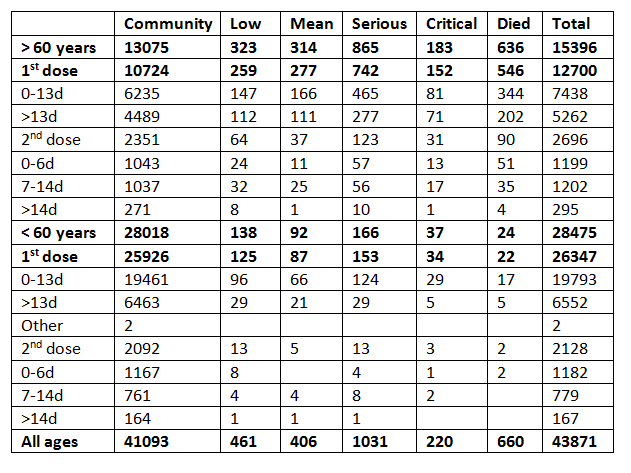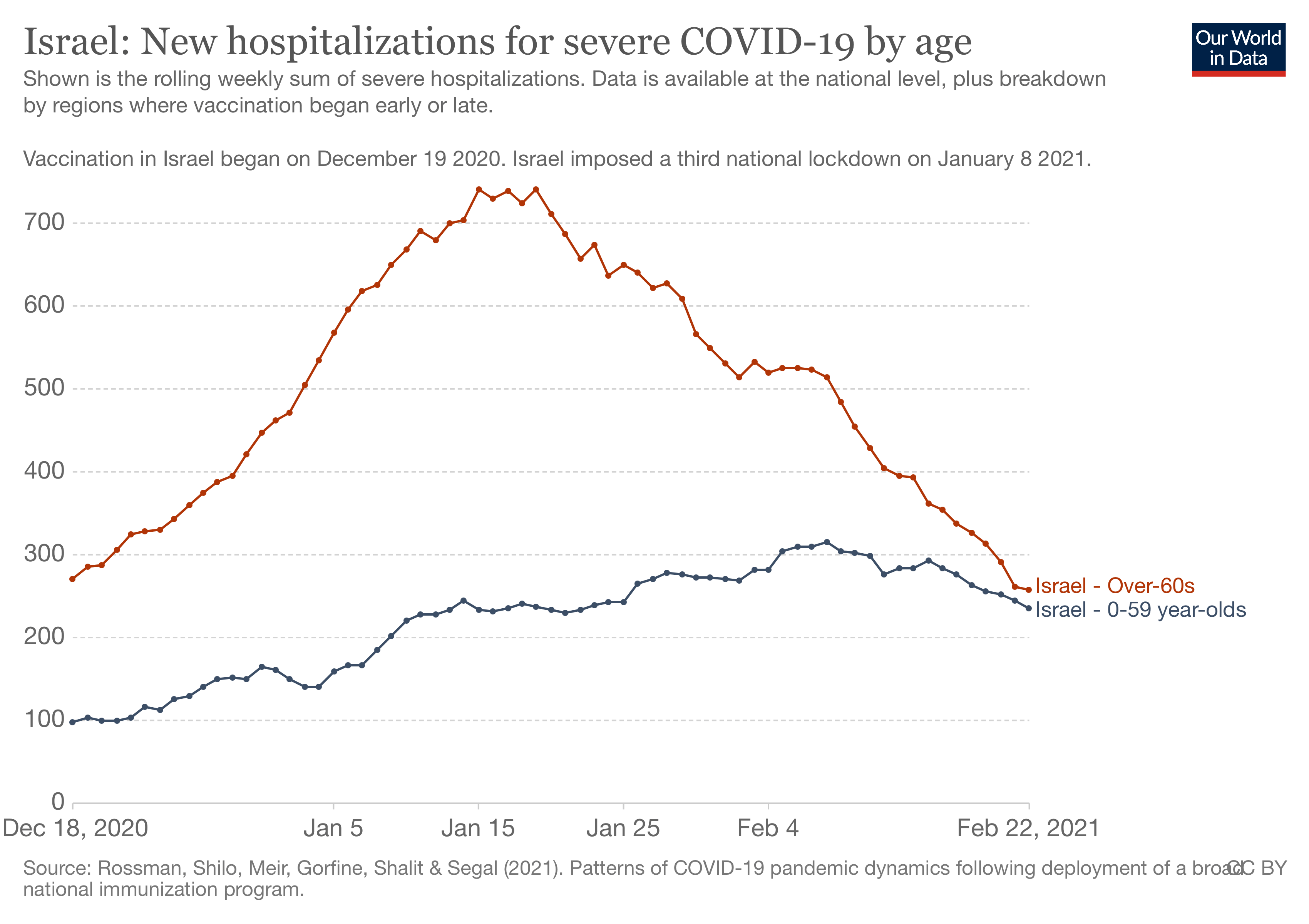
Misleading: The Pfizer-BioNTech COVID-19 vaccine requires two doses to achieve its full efficacy of 95%. It can also take several weeks for immunity to fully develop. The data showed that the majority of COVID-19 deaths in vaccinated people occurred in those who had received only one dose. This isn’t as unexpected as the post claimed, as these people hadn’t fully developed immunity and were still as vulnerable to COVID-19 as unvaccinated people.

FULL CLAIM: “We conclude that the Pfizer vaccines, for the elderly, killed during the 5-week vaccination period about 40 times more people than the disease itself would have killed, and about 260 times more people than the disease among the younger age class.”; “most serious hospitalized cases on February 10 or at a near date were in fact vaccinated with the first dose or up to two weeks after the second dose”; “vaccination promotes deaths because 51.9% of deaths [...] are for the 12.5% vaccinated”
REVIEW
A forum post made by Haim Yativ on a Hebrew-language discussion board claimed that the Pfizer-BioNTech COVID-19 vaccine “killed […] about 40 times more [elderly people] than the disease itself would have killed, and about 260 times more people than the disease” in younger age groups. The post purported to show evidence of this through an analysis based on data provided by the Israeli Ministry of Health, that was published by the Israeli news outlet Ynet on 11 February 2021. According to Yativ, Hervé Seligmann, a scientist who studies evolutionary biology at Aix-Marseille University, collaborated with him on the analysis.
The forum post was later picked up by English-language outlets, such as Children’s Health Defense, an organization that opposes vaccinations, and GreenMedInfo. Their articles received more than 8,000 interactions on social media platforms, including Facebook and Instagram. The claim was also disseminated in the form of memes, like this one. Both outlets published misinformation about COVID-19 and vaccines in the past.
However, the analysis is unsound, as it involved several flawed and misleading assumptions that render the calculations meaningless. In no way do they support the claim that the vaccine killed people, as this review explains below.
Vaccination doesn’t result in instant protection from COVID-19; it can take several weeks to fully develop immunity, during which people remain as vulnerable to the disease as unvaccinated people
The post depended heavily on a table of data from the Israeli Ministry of Health, published by Ynet, showing that among all individuals aged 60 years old and above, who had received at least one dose of the Pfizer-BioNTech vaccine, there were 865 who developed serious cases of COVID-19. The original table in Hebrew can be found in the Ynet article. The table, translated to English in Yativ’s post, is provided below (Table 1).

Table 1. The English translation of the table of outcomes observed in 43,871 vaccinated people in Israel. On the left column, the data is stratified according to age group, number of doses administered, and the number of days post-vaccination. The top row indicates the severity of COVID-19.
The post then pointed to data from the Israeli Ministry of Health’s COVID-19 dashboard, which showed there were 1,056 active serious cases on 11 February 2021. The post concluded that this meant “most serious hospitalized cases on February 10 or at a near date were in fact vaccinated with the first dose or up to two weeks after the second dose”, and called this “surprising”.
However, this isn’t a surprise. If we take a closer look at the table, we can see that the majority of people above 60 years old who were vaccinated and had serious COVID-19 had only one dose less than two weeks ago (465 out of 865). Scientists know that it can take up to several weeks for the vaccine to fully induce protection. Furthermore, two doses are required for the vaccine to achieve its full efficacy, estimated at 95%. But the post failed to take this caveat into account in its analysis of COVID-19 death rates.
Comparing the number of serious COVID-19 cases between people who were vaccinated, but had not yet fully developed immunity, and people who were vaccinated and protected, would have shown that the vaccine is beneficial.
For example, among all 7,438 elderly people who had received just one dose less than two weeks ago, there were 465 serious COVID-19 cases (about 6.3 percent). Contrast this with 10 cases of serious COVID-19 in 295 elderly people who had received two doses at least two weeks ago (about 3.4 percent). This indicates that the vaccine reduces the likelihood of dying from COVID-19. It also highlights the importance of receiving two doses of the vaccine.
Indeed, Israel is seeing COVID-19 cases plummet as its vaccination campaign progresses. The claim that the vaccine causes more serious COVID-19 cases in the young and old doesn’t square up with real-life observations, given that the number of COVID-19 hospitalizations has been falling as the number of complete vaccinations increase (see figure below). If the post’s claim were true, we would be seeing a rising number of COVID-19 hospitalizations as the number of vaccinations increase, but the opposite is happening.

Figure 1. Hospitalizations for severe COVID-19, stratified by age group. Israel’s vaccination campaign began on 20 December 2020. Data and graph extracted from Our World in Data on 8 March 2021.
VAERS isn’t an adequate database for calculating the incidence rate of adverse events
The post claimed that the vaccine killed many more people than would have died from COVID-19. To do this, they compared the rate of COVID-19 deaths in vaccinated people in Israel with the death rate reported to the U.S. Vaccine Adverse Events Reporting System, or VAERS for short, which the author alleged to be 0.2%. But even the reliability of this figure is in question, as it is unclear how the authors collected and analyzed the VAERS data.
VAERS is a surveillance system that collects self-reports of adverse events occurring after vaccination, ranging from turning into the Hulk to car accidents to deaths.
In order to calculate an incidence rate, one requires the number of all or most adverse events among a particular group, such as vaccinated people or unvaccinated people. But because VAERS relies on self-reports, it isn’t reliable for calculating the incidence rates of an adverse event among a given population, such as death. For example, it doesn’t capture all deaths that occur after vaccination, nor does it capture all COVID-19 vaccinations (although the U.S. Centers for Disease Control and Prevention keeps a running count on a separate webpage). In other words, the database is incomplete.
Indeed, to determine whether the vaccine caused people to die at a faster rate, we could simply compare the incidence of deaths between vaccinated and unvaccinated people in the same age group.
In fact, such an analysis for the Pfizer-BioNTech COVID-19 vaccine has been done. The Global Advisory Committee on Vaccine Safety (GACVS) reviewed the information and data on deaths in frail, elderly individuals that occurred after receipt of the Pfizer-BioNTech COVID-19 vaccine. The GACVS is “a scientific and clinical advisory body to” the World Health Organization (WHO), which “aims to provide a reliable and independent scientific assessment of vaccine safety issues”. The GACVS is not itself part of the WHO.
On 22 January 2021, the GACVS subcommittee released the following statement after completing the review:
“Based on a careful scientific review of the information made available, the subcommittee came to the following conclusions:
The current reports do not suggest any unexpected or untoward increase in fatalities in frail, elderly individuals or any unusual characteristics of adverse events following administration of BNT162b2. Reports are in line with the expected, all-cause mortality rates and causes of death in the sub-population of frail, elderly individuals, and the available information does not confirm a contributory role for the vaccine in the reported fatal events. In view of this, the committee considers that the benefit-risk balance of BNT162b2 remains favourable in the elderly, and does not suggest any revision, at present, to the recommendations around the safety of this vaccine.
Countries should continue to monitor the safety of vaccines, and promote routine after-care following immunization, consistent with good immunization practices for any vaccine. The committee recommends that data on suspected adverse events should be collected and reviewed continuously – nationally, regionally, and globally – as the COVID-19 vaccines are rolled out, world-wide.
The GACVS subcommittee will continue to monitor the safety data from these vaccines and update any advice as necessary.” (emphasis added)
In other words, the rate of mortality observed in these elderly populations aren’t higher when compared to an unvaccinated population of the same age group. This suggests that the COVID-19 vaccine was not associated with the deaths, and these deaths occurred by coincidence.
Citing Table 1, the post claimed that there were “660 COVID-19 deaths among the vaccinated” and that this made up “51.9% of the [COVID-19] deaths for that period”. It then claimed that since “Only 1.3 million Israeli, among 8 million (about 1 in 8, 12.5%), were vaccinated during that period”, this must mean that “vaccination promotes deaths because 51.9% of deaths during that period are for the 12.5% vaccinated in that period.” But again, this calculation failed to distinguish between groups that were vaccinated and protected, and those which were vaccinated but had not yet developed full immunity to COVID-19.
As we can see from Table 1, 546 of these 660 deaths occurred in the elderly population that had only received one dose of the vaccine. 22 of 660 deaths occurred in those below 60 years old who had received only one dose. Contrast these numbers with those who had received two doses: 90 deaths in the elderly and two deaths in those aged below 60. In other words, 568 out of 660 deaths (about 86 percent) occurred in vaccinated people who were still vulnerable to COVID-19. Just 14 percent of deaths occurred in people who had received both doses.
If the vaccine did make people more likely to die from COVID-19, as the post claimed, we would expect to see at least similar rates of COVID-19 deaths in both one-dose and two-dose groups, or perhaps even a higher death rate in people who had received two doses.
But the data isn’t consistent with the claim. Table 1 shows 546 COVID-19 deaths in 12,700 elderly people who had received one dose, or a ratio of 0.042. In 2,676 elderly people who had received two doses, there were 90 COVID-19 deaths, or a ratio of 0.03. This is 1.4 times smaller than the ratio for the first dose.
Overall, these figures are inconsistent with the post’s conclusion that the vaccine causes more COVID-19 deaths. Instead, they suggest that the vaccine protects a person from dying of COVID-19.
The data showed that people who were fully vaccinated were less likely to die from COVID-19
In the run-up to its conclusion, it once again used the questionable 0.2% death rate derived from VAERS data: “Among those vaccinated and above 65, 0.2% of those vaccinated died during the 3-week period between doses”, which would equate to “about 200 among 100000 vaccinated”.
The post compared this figure of 200 in 100,000 to “the 4.91 dead among 100000 dying from COVID-19 without vaccination”, based on another table published in the Ynet article showing the incidence of COVID-19 deaths (see Table 2 for the English translation provided by the post), thereby arriving at its central claim: that “about 40 times more” elderly people died from the vaccine than would have died from COVID-19.

Table 2. The English translation of the table showing the incidence of COVID-19 deaths in unvaccinated people and vaccinated people who had received two doses at least two weeks ago (who would have fully developed immunity). Data is stratified by age group and vaccination status. “Vaccination complete” indicates vaccinated people who received two doses of the vaccine at least two weeks ago.
However, Table 2 shows that vaccinated elderly people who had received two doses at least two weeks ago had a much lower incidence of COVID-19 deaths (0.279 per 100,000 people) compared to those who hadn’t been vaccinated (4.91 per 100,000). The number of doses and the length of time after both doses are important pieces of context—as explained above, only people who received two doses of the vaccine at least two weeks ago are expected to reap the full benefits of the vaccine.
But the author discarded this observation and stated that “This should not be confused with the COVID-19 0.279 deaths among 100000 reported for those who completed the vaccination process, meaning 2 weeks after the second dose”. He didn’t use this figure in the analysis and gave no explanation as to why the figure of 0.279 per 100,000 was excluded.
Overall, its claim that “40 times more” elderly people died from the vaccine than would have died from COVID-19 itself was founded on an unreliable incidence of death using VAERS and the inaccurate assumption that the only thing that explains COVID-19 deaths in vaccinated people is the vaccine. In fact, the data showed that the vaccine greatly reduces one’s likelihood of dying from COVID-19, provided that people receive both doses at least a few weeks earlier.
Conclusion
The forum post’s claim that the vaccine led to more COVID-19 deaths than the disease itself would have caused isn’t supported by the data that it used. In its analysis of COVID-19 death rates in vaccinated people, it consistently failed to account for the fact that the two doses of the Pfizer-BioNTech vaccine are necessary for its full efficacy. It also didn’t account for the fact that vaccination doesn’t lead to instant protection and developing vaccine-induced immunity can take up to several weeks. Instead the post wrongly assumed that any COVID-19 death that occurred after a person was vaccinated must be due to the vaccine.
By failing to stratify its analysis accordingly to account for these caveats, the results of the analysis paint an inaccurate and misleading picture of the vaccine’s efficacy and safety. In fact, the data demonstrate that the vaccine reduces the likelihood of dying from COVID-19.
Furthermore, real-world observations are incompatible with the post’s assertion that the vaccine causes more serious cases of COVID-19: Israel has seen the number of COVID-19 hospitalizations, as well as the number of COVID-19 cases, fall as the number of completed vaccinations rise.
CORRECTION (8 Apr. 2021):
We previously stated that there was a ratio of 0.42 deaths among 12,700 elderly people who had received one dose of the vaccine. This is incorrect. The correct ratio is 0.042.


